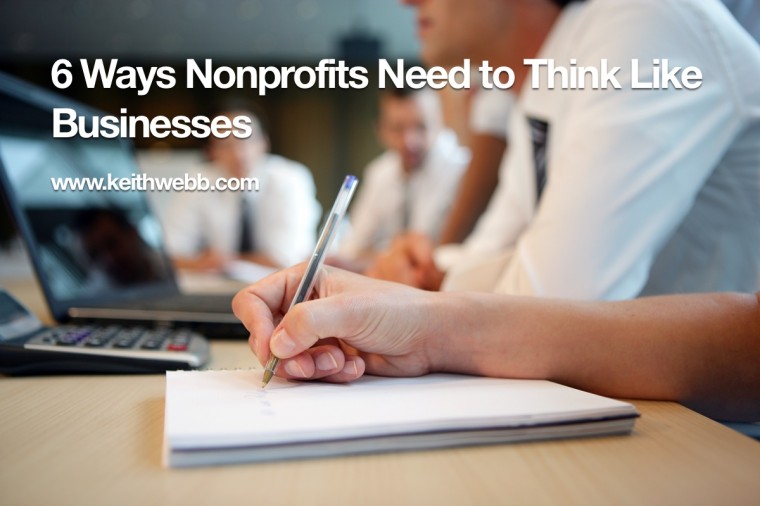There’s a mindset among many nonprofit leaders that says their organizations shouldn’t run like businesses. The fact is, however, if nonprofits learn to think more like businesses they will serve more people and see more lives changed.

Nonprofits often operate from donor income, receive what volunteers want to give, and provide their services at little or no cost. After all, the purpose of a nonprofit organization is to change lives.
The visionary nature of nonprofits makes them susceptible to thinking that their cause is so noble and urgent that they don’t have time to waste on organizational niceties that businesses must do. People are drinking dirty water, or living without adequate housing or education. So who has time to worry about proper management?
This “urgent-ends justifies inadequate means” mindset keeps nonprofits from reaching the level of impact that they desire. By applying a few principles that businesses take for granted, your nonprofit can steward its resources, multiply its impact and change more lives.
6 Ways Nonprofits Need to Think Like Businesses
- Don’t hire for vision. Walt Disney said, “Hire for character, train for skill.” My corollary is, “Hire for character, train for skill, then inspire vision.” Too often nonprofits hire or accept volunteers based on a person’s passion for the organization’s vision. They end up with people not willing or unable to do the real-world work of delivering your visionary services.
- Profits do matter. Profit is the money remaining after all expenses are paid out. By this definition, a nonprofit still makes a profit. In a nonprofit, these excess funds will be rolled back into providing services, rather than paid to shareholders. A lack of profit doesn’t always point to giving everything away. It could be due to poor planning, wasteful management, or undervalued products and services that generate some revenue.
- Marketing is not a four-letter word. Marketing is simply getting the word out about what you do to change lives, and inviting others to join you. There are good ways and bad ways to market. Cheesy marketing is about taking. Convincing. Selling. Good marketing gives, inspires, and adds value to people. It requires little selling because people have already benefitted from what you have given them. Serve donors and when it comes time to make a request, you can ask it softly.
- Don’t give everything away. Nonprofits can confuse generosity with empowerment, giving away or too heavily discounting services and products it provides. Free is often not the most empowering. Those you serve may feel more committed, empowered, and generate the resourcefulness they need in the long-term if there’s a price tag to what you provide. It could be cash, but also volunteering their time. Your organization’s financial state would also improve with a 10, 25, or 40% boost in fees-for-service income.
- You get what you pay for. Your organization needs services like design, databases, administration, and travel. It’s nice if you can get a discount for these services because you are a nonprofit, but don’t limit yourself to service providers that will offer pro-bono or discounted services. It doesn’t matter that you serve people for free or at a reduced cost, the price of excellent services will often be the same as what businesses pay. Otherwise, you’ll spend more effort and money in the long run patching together half-baked discount services.
- Effective processes change lives. It’s not how much money you raise that matters, but how well you use it. Organizational processes that are efficient and effective will help you deliver more of the services that change lives. Stewardship is the point. Inefficient organizational processes waste the resources – energy, things, and money – that make deep impact on the people you serve.
These 6 ways of thinking challenge the assumptions with which nonprofits unconsciously operate. If reading this article stirs something in you, don’t let inertia or discouragement over previous efforts to change keep you from acting.
Two Approaches To Implementation
As I’ve applied these 6 ways of thinking to my work with nonprofits, they’ve found two approaches helpful.
Go for immediate, small wins. Share this article with your colleagues or team. Pick one or two ways that most resonate with you. Create a couple of action steps you could immediately implement, which will produce small wins. Then, look for the next couple of small wins. And keep going from there.
Some changes require a more systemic approach. This kind of intervention requires you to dismantle a more complex practice that touches multiple areas. For example, beginning to charge fees for some of your services requires planning with multiple stakeholders and a series of implementation points.
Do the immediate small wins at the same time as you go after larger systemic changes. The small wins will motivate and encourage the longer-term actions needed for the systemic changes.
Question: In what ways does your nonprofit think like a business? You can leave a comment by clicking here.


Please note: I reserve the right to delete comments that are offensive or off-topic. You own your comments but give me permission to use them. See My Comments Policy. Read my Permissions Policy to know how you can use my posts.